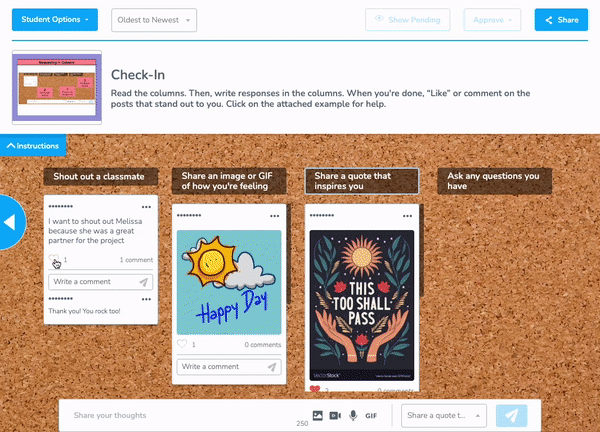
Higher education data driven approaches to boost student learning
PowerPoint and traditional lectures in higher education are the status quo on how we teach students, but is this enough to attract, and, more importantly, keep the attention of our new generation of students? While these methods have their place, we advocate for turning passive lecture sessions into active ones, using a data driven approach that encourages students to think critically about course content and self-assess their performance.
Embed assessments into lectures with Nearpod
In this pursuit, technology offers us a valuable ally, and Nearpod is a prime example. With Nearpod’s interactive features, you can transform your traditional PowerPoint presentations into engaging, participatory learning experiences. Through its interactive activities and slides, you can seamlessly integrate open-ended questions, polls, quizzes, and collaborative activities, enabling students to actively engage with the content and with each other. This enables students to actively participate in the content and with peers while providing instructors with immediate, real-time insights into student comprehension. Collecting students’ performance data through these tools will support educators in their data driven approaches by making adjustments in the moment and using those insights to guide future instruction.
New to Nearpod? Book a demo with one of our experts and learn how you can empower educators with unlimited access to everything they need to engage learners.
A better way to gather data insights in higher education
Throughout the history of higher education, evaluating our teaching methods has often been an exercise in trial and error. Whether the instructional method we choose is self-created or derived from a research-based best practice, we tend to use qualitative observational data to assess the success of each lesson. Unfortunately, this self-assessment doesn’t typically properly provide feedback on whether or not we’ve achieved our ultimate goal as instructors – positively influencing improved student performance outcomes. Feeling that students were engaged or liked a lesson doesn’t necessarily indicate that they learned and retained the information presented, just as students complaining about a learning activity doesn’t mean that they did not learn the material.
Only by evaluating student performance through exam data, normally toward the end of the term or semester when it may be too late to course correct, can we identify which teaching methods best influence improved student performance through data driven instruction. Additionally, data driven decision making in higher education has become increasingly important as institutions leverage data to enhance instruction and improve student outcomes.
Collect student performance data through active lectures
Let’s quickly address a couple of elephants in the room. First, if you have teaching experience, you likely have PowerPoint experience. It’s how many of us were taught and how many of us learned how to teach – no shame in that. Secondly, the easiest and most time-efficient way to get a lot of information to a large group of people in a live setting is a good old-fashioned lecture. As someone who promotes and teaches active learning instructional methods, that last one was pretty tough for me to admit publicly.
It’s okay to lecture (it really is!) but let’s follow the student performance data and engage our learners with course content by turning these typically passive learning sessions into active lectures. Active lectures are teaching sessions that still allow faculty and students to operate in their most familiar classroom setting, while also requiring students to think critically about course content, receive feedback on their performance, and provide students the opportunity to self-assess their performance in comparison with their peers. How have faculty in our program accomplished this, you ask? Here are three data driven approaches (that are easy to implement) that will help you achieve that ultimate teaching goal – influencing improved student outcomes.
3 Data driven approaches to improve student performance
1. Engage all students with interactive questions for improved learning and participation
Pausing and asking students questions while lecturing is fairly common, but what information do we really gather as faculty using this technique? And how do we ensure that we are hearing from every student, and not just the few brave souls that raise their hands to speak? Let me elaborate with a personal example. When I was a student teacher, I was fortunate enough to have a GREAT cooperating teacher – Chuck Harlow, at Northmont High School. During some of my teaching sessions, Chuck would sit in the back of the room and make tallies on the seating chart each time I called on a student. I’ll never forget the first time Chuck asked me how I thought I did after a long day of teaching. I very proudly thought I did well and that the students learned what I was teaching. When asked to share how I knew the students learned, I said that students were following along, nodding, and answering the questions I asked during class. And that’s when Chuck hit me with a lesson that has clearly stuck with me for the last 15+ years. He showed me the tallies. For each class of 30ish students, I had called on maybe 5-6 per period. So, I knew what about 20% (at best) of my students knew about the content I was teaching that day. When pressed about what the other 80% of students learned that day, I had nothing. Extrapolating those numbers to large lecture classrooms we’re typically hearing from an incredibly small percentage of our students. So, it’s time to fix that.
Asking written open-ended questions engages all students with course content while holding them accountable for providing an answer. So, while you may only be able to call on a select number of students during class, all students can now engage with the course content and provide their thoughts. Professors can always see each students’ performance data on their screen. However, if you’d like to share responses with the class for peer collaboration, you can make students’ responses anonymous during these interactive slides to encourage even the most tentative students to submit answers.
The more reps students get critically applying content learned will encourage more long-term retention of course content while also providing opportunities for students to self-assess their knowledge of course content. If an open-ended question doesn’t make sense for your lesson, you also have other similar options in Nearpod to support this data driven approach, such as Polls, Quizzes, or Draw It’s that may serve the same purpose.
2. Gain insights through student collaboration and peer communication
Engagement is more than just students engaging with the content, they should also engage with their instructors and peers. Why? Well, first and foremost, formative assessments serve as a two-way communication tool. This is your opportunity as the teacher to create assessments that emphasize the key terms and concepts while students are communicating back to you their level of mastery of the course content. They learn from you which is the most important information to study/practice, while you can use their performance data to focus remediation efforts and upcoming lessons on where students are struggling the most.
When students exchange ideas with their peers, it broadens and deepens the class discussions. Students have the opportunity to play the role of instructor by offering new concepts or explanations to their classmates – and we all know that we learn best by teaching. Not to mention, peer collaboration allows students to self-assess their personal progress against their classmates. If they can’t contribute to or keep up with the conversation, they know they need to improve in that area. Students don’t always innately self-assess, so don’t forget to remind students that they should be self-assessing their progress! Reflection will help them better focus their study time outside of class.
Educators can accomplish this through Nearpod’s Collaborate Board! Collaborate Board is a virtual board of “post-it notes” that allows students to quickly share ideas and comments through text and multimedia with their classmates. All responses are visible to the class, and students can interact with each other’s responses by “hearting” or adding comments to them. For faculty, this engagement tool couldn’t be easier to create – add the board to your presentation, pose a question or thinking prompt, add a reference image if you like, and share the lesson with students to have them post their answers. These answers will quickly and organically drive your lesson forward through the student answers provided while also giving you the opportunity to reinforce positive performance and correct any learning concerns right there in the moment.
If you’re really looking to gain insights into your students’ ability to think critically about and apply concepts learned through a data driven approach, use Collaborate Board to ask students to provide what they would need to learn next to further their knowledge on the topic. Having students provide their personal learning objectives provides a unique window into how students are thinking about course content, giving you the information needed to either continue with your current unit plan or readjust to help students get back on track. These engagements are a BIG part of the year-over-year improved student performance we’ve seen in our program!
3. Provide targeted self-paced practice opportunities
After assessing students’ knowledge in class, providing them feedback, and encouraging them to self-assess their performance, it’s time to create self-paced practice materials that help them target where they need to improve. The best way to quantifiably identify where students are struggling the most is to use Quiz questions in your Nearpod presentations. The percent correct is provided for each question, so the information is easy to access and digest.
Pro-tip: Make a note of the general content area each Quiz or individual Quiz question addresses. After your presentation, review the student performance on these content areas as a whole. This will allow you to target the areas of greatest concern with self-paced modules.
These real-time remediation modules can help students focus their study time where they need it the most instead of spending their time practicing on areas of your course where they’re already proficient. The more opportunities students have to practice applying concepts, the more likely they are to turn these lessons learned into long-term retention of course content.
Self-paced practice isn’t just for struggling students! These modules are also great in helping students apply content in more practical scenarios. Throughout higher education, one of the more common concerns faculty voice is that students struggle with critical thinking and applying concepts to problem solve. These self-paced practice modules can be created with a focus on giving students more repetitions sharpening these skills. The more reps, the more likely students are to develop these critical thinking skills.
Previously, creating these types of targeted materials wasn’t possible because it took too much time, but with the advent of artificial intelligence, we can have these materials created for us. If you’d like to learn more about that, check out this webinar: Work Smarter, Not Harder: Streamlining and Enhancing Educational Content Creation with AI & Nearpod!
Following students’ completion of the modules, educators should bridge the gap between this stage and the receipt of exam results. During this critical timeframe, professors can conduct additional class assessments, specifically tailored to address the areas of concern identified through data analysis. By conducting targeted assessments and making data-driven decisions, instructors can create self-paced remediation modules, if needed, that help students pinpoint their weaknesses, thus optimizing their study time and overall learning experience.
The impactful results of active lectures through data driven approaches
Using Nearpod’s engaging formative assessment features, we’ve witnessed meaningful improvement in student performance on our summative exams (and we have the data to prove it!). By implementing these easy-to-create and powerful methods, you can see the same improvement with your students! And at the end of the day, that’s the most impactful thing we can do as teachers – positive influence improved student outcomes.
This table illustrates the year-over-year change in student exam performance after one faculty member switch from teaching solely with PowerPoint to using Nearpod for all of their lessons.
Bring Nearpod to your department or institution to implement these approaches
If you are still using PowerPoint and traditional lectures in your higher education courses, that’s okay. However, I challenge you to break the status quo and open up to data driven instruction, to take the leap and transform passive lectures into active ones. With these 3 data driven approaches using Open Ended Questions to hear every student’s voice, sparking inclusive discussion in Collaborate Board, and encouraging critical thinking and real-world application through self-paced practice, you will have a great starting point to improving overall student performance like the students from my institution.
Join hundreds of faculty and institutions elevating instruction worldwide. Engage 100% of your students with interactive activities delivered live or asynchronously on any device with Nearpod.
New to Nearpod? Book a demo with one of our experts and learn how you can empower educators with unlimited access to everything they need to engage learners.

Currently the Assistant Director of Faculty Development and Instructional Design at Oklahoma State University (OSU) College of Veterinary Medicine, Dan transitioned from teaching high school to focusing on curriculum and educational technology in higher education. Throughout his career he has assisted faculty in course design and development, while also introducing new methods of utilizing educational technology in the curriculum to create a learner-centered environment. His background includes leading faculty development efforts at OSU Center for Health Sciences and Kent State University College of Podiatric Medicine. He holds a Master of Science in Technology Enhanced Learning and a Bachelor of Science in Adolescent/Young Adult Education from the University of Dayton.





